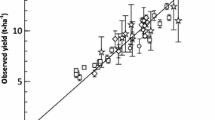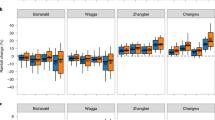Abstract
To better understand how climate change might influence global canola production, scientists from six countries have completed the first inter-comparison of eight crop models for simulating growth and seed yield of canola, based on experimental data from six sites across five countries. A sensitivity analysis was conducted with a combination of five levels of atmospheric CO2 concentrations, seven temperature changes, five precipitation changes, together with five nitrogen application rates. Our results were in several aspects different from those of previous model inter-comparison studies for wheat, maize, rice, and potato crops. A partial model calibration only on phenology led to very poor simulation of aboveground biomass and seed yield of canola, even from the ensemble median or mean. A full calibration with additional data of leaf area index, biomass, and yield from one treatment at each site reduced simulation error of seed yield from 43.8 to 18.0%, but the uncertainty in simulation results remained large. Such calibration (with data from one treatment) was not able to constrain model parameters to reduce simulation uncertainty across the wide range of environments. Using a multi-model ensemble mean or median reduced the uncertainty of yield simulations, but the simulation error remained much larger than observation errors, indicating no guarantee that the ensemble mean/median would predict the correct responses. Using multi-model ensemble median, canola yield was projected to decline with rising temperature (2.5–5.7% per °C), but to increase with increasing CO2 concentration (4.6–8.3% per 100-ppm), rainfall (2.1–6.1% per 10% increase), and nitrogen rates (1.3–6.0% per 10% increase) depending on locations. Due to the large uncertainty, these results need to be treated with caution. We further discuss the need to collect new data to improve modelling of several key physiological processes of canola for increased confidence in future climate impact assessments.






Similar content being viewed by others
Data and code availability
Data and code will be made available on reasonable request.
References
Angus JF, Van Herwaarden AF, Howe GN (1991) Productivity and break crop effects of winter-growing oilseeds. Aust J Exp Agric 31:669–677. https://doi.org/10.1071/EA9910669
Angus JF, Kirkegaard JA, Hunt JR et al (2015) Break crops and rotations for wheat. Crop Pasture Sci 66:523–552
Anwar MR, Liu DL, Farquharson R et al (2015) Climate change impacts on phenology and yields of five broadacre crops at four climatologically distinct locations in Australia. Agric Syst 132:133–144. https://doi.org/10.1016/j.agsy.2014.09.010
Asseng S, Ewert F, Rosenzweig C et al (2013) Uncertainty in simulating wheat yields under climate change. Nat Clim Chang 3:827–832. https://doi.org/10.1038/nclimate1916
Asseng S, Ewert F, Martre P et al (2015) Rising temperatures reduce global wheat production. Nat Clim Chang 5:143–147. https://doi.org/10.1038/nclimate2470
Asseng S, Ewert F, Martre P et al (2016) Benchmark data set for wheat growth models: field experiments and AgMIP multi-model simulations. Open Data J Agric Res 1:1. https://doi.org/10.18174/odjar.v1i1.14746
Bassu S, Brisson N, Durand JL et al (2014) How do various maize crop models vary in their responses to climate change factors? Glob Change Biol 20:2301–2320. https://doi.org/10.1111/gcb.12520
Battisti R, Sentelhas PC, Boote KJ (2017) Inter-comparison of performance of soybean crop simulation models and their ensemble in southern Brazil. Field Crop Res 200:28–37. https://doi.org/10.1016/j.fcr.2016.10.004
Boote KJ, Porter CH, Hargreaves J et al (2015) AgMIP training in multiple crop models and tools. In: Rosenzweig C, Hillel D (eds) Handbook of climate change and agroecosystems: the Agricultural Model Intercomparison and Improvement Project (AgMIP) integrated crop and economic assessments. pp 393–410
Chapagain T, Good A (2015) Yield and production gaps in rainfed wheat, barley and canola in Alberta. Front Plant Sci 6:1–10. https://doi.org/10.3389/fpls.2015.00990
Deligios PA, Farci R, Sulas L et al (2013) Predicting growth and yield of winter rapeseed in a Mediterranean environment: model adaptation at a field scale. Field Crop Res 144:100–112. https://doi.org/10.1016/j.fcr.2013.01.017
Diepenbrock W (2000) Yield analysis of winter oilseed rape (Brassica napus L.): a review. Field Crop Res 67:35–49. https://doi.org/10.1016/S0378-4290(00)00082-4
Durand JL, Delusca K, Boote K et al (2016) How accurately do maize crop models simulate the interactions of atmospheric CO2 concentration levels with limited water supply on water use and yield? Eur J Agron. https://doi.org/10.1016/j.eja.2017.01.002
FAO (2016) The Food and Agriculture Organization of the United Nations. In: Statistic data base. http://faostat.fao.org/
Fargione J, Hill J, Tilman D et al (2008) Land clearing and the biofuel carbon debt. In: Science. http://www.sciencemag.org.focus.lib.kth.se/content/319/5867/1235
Fleisher DH, Condori B, Quiroz R et al (2017) A potato model intercomparison across varying climates and productivity levels. Glob Change Biol 23:1258–1281. https://doi.org/10.1111/gcb.13411
Folberth C, Elliott J, Müller C et al (2019) Parameterization-induced uncertainties and impacts of crop management harmonization in a global gridded crop model ensemble. PLoS ONE 14:e0221862. https://doi.org/10.1371/journal.pone.0221862
Franke JA, Müller C, Elliott J et al (2020a) The GGCMI Phase 2 experiment: global gridded crop model simulations under uniform changes in CO2, temperature, water, and nitrogen levels (protocol version 1.0). Geosci Model Dev 13:2315–2336. https://doi.org/10.5194/gmd-13-2315-2020
Franke JA, Müller C, Elliott J et al (2020b) The GGCMI Phase 2 emulators: global gridded crop model responses to changes in CO2, temperature, water, and nitrogen (version 1.0). Geosci Model Dev 13:3995–4018. https://doi.org/10.5194/gmd-13-3995-2020
Franzaring J, Högy P, Fangmeier A (2008) Effects of free-air CO2 enrichment on the growth of summer oilseed rape (Brassica napus cv. Campino). Agr Ecosyst Environ 128:127–134. https://doi.org/10.1016/j.agee.2008.05.011
George N, Kaffka S (2017) Canola as a new crop for california: a simulation study. Agron J 109:496–509. https://doi.org/10.2134/agronj2016.04.0247
Gungula DT, Kling JG, Togun AO (2003) CERES-Maize predictions of maize phenology under nitrogen-stressed conditions in Nigeria. Agron J 95:892–899. https://doi.org/10.2134/agronj2003.0892
He D, Wang E, Wang J et al (2017a) Uncertainty in canola phenology modelling induced by cultivar parameterization and its impact on simulated yield. Agric for Meteorol 232:163–175. https://doi.org/10.1016/j.agrformet.2016.08.013
He D, Wang E, Wang J, Lilley JM (2017b) Genotype × environment × management interactions of canola across China: a simulation study. Agric For Meteorol 247:424–433. https://doi.org/10.1016/j.agrformet.2017.08.027
He D, Wang E, Wang J, Robertson MJ (2017) Data requirement for effective calibration of process-based crop models. Agric For Meteorol 234–235:136–148. https://doi.org/10.1016/j.agrformet.2016.12.015
Högy P, Franzaring J, Schwadorf K et al (2010) Effects of free-air CO2 enrichment on energy traits and seed quality of oilseed rape. Agr Ecosyst Environ 139:239–244. https://doi.org/10.1016/j.agee.2010.08.009
Jin Z, Zhuang Q, Tan Z et al (2016) Do maize models capture the impacts of heat and drought stresses on yield? Using algorithm ensembles to identify successful approaches. Glob Change Biol 22:3112–3126. https://doi.org/10.1111/gcb.13376
Jing Q, Shang J, Qian B et al (2016) Evaluation of the CSM-CROPGRO-canola model for simulating canola growth and yield at west nipissing in eastern Canada. Agron J 108:575–584. https://doi.org/10.2134/agronj2015.0401
Li T, Hasegawa T, Yin X et al (2015) Uncertainties in predicting rice yield by current crop models under a wide range of climatic conditions. Glob Change Biol 21:1328–1341. https://doi.org/10.1111/gcb.12758
Marin FR, Thorburn PJ, Nassif DSP, Costa LG (2015) Sugarcane model intercomparison: Structural differences and uncertainties under current and potential future climates. Environ Model Softw 72:372–386. https://doi.org/10.1016/j.envsoft.2015.02.019
Martre P, Wallach D, Asseng S et al (2015) Multimodel ensembles of wheat growth: Many models are better than one. Glob Change Biol 21:911–925. https://doi.org/10.1111/gcb.12768
Mcvetty P, Duncan R (2016) Canola/rapeseed: genetics and breeding. In: Ref Mod Food Sci
Müller C, Elliott J, Kelly D et al (2019) The Global Gridded Crop Model Intercomparison phase 1 simulation dataset. Sci Data 6:50. https://doi.org/10.1038/s41597-019-0023-8
Palosuo T, Kersebaum KC, Angulo C, et al (2011) Simulation of winter wheat yield and its variability in different climates of Europe: a comparison of eight crop growth models. Eur J Agron 35. https://doi.org/10.1016/j.eja.2011.05.001
Ray DK, Ramankutty N, Mueller ND et al (2012) Recent patterns of crop yield growth and stagnation. Nat Commun 3:1293. https://doi.org/10.1038/ncomms2296
Robertson MJ, Lilley JM (2016) Simulation of growth, development and yield of canola (Brassica napus) in APSIM. Crop Pasture Sci 67:332–344. https://doi.org/10.1071/CP15267
Rondanini DP, Gomez NV, Agosti MB, Miralles DJ (2012) Global trends of rapeseed grain yield stability and rapeseed-to-wheat yield ratio in the last four decades. Eur J Agron 37:56–65. https://doi.org/10.1016/j.eja.2011.10.005
Rosenzweig C, Jones JW, Hatfield JL et al (2013) The Agricultural Model Intercomparison and Improvement Project (AgMIP): protocols and pilot studies. Agric for Meteorol 170:166–182. https://doi.org/10.1016/j.agrformet.2012.09.011
Rosenzweig C, Elliott J, Deryng D et al (2014) Assessing agricultural risks of climate change in the 21st century in a global gridded crop model intercomparison. PNAS 111:3268–3273. https://doi.org/10.1073/pnas.1222463110
Rötter RP, Palosuo T, Kersebaum KC et al (2012) Simulation of spring barley yield in different climatic zones of Northern and Central Europe: a comparison of nine crop models. Field Crop Res 133:23–36. https://doi.org/10.1016/j.fcr.2012.03.016
Salo TJ, Palosuo T, Kersebaum KC et al (2016) Comparing the performance of 11 crop simulation models in predicting yield response to nitrogen fertilization. J Agric Sci 154:1218–1240. https://doi.org/10.1017/S0021859615001124
van Duren I, Voinov A, Arodudu O, Firrisa MT (2015) Where to produce rapeseed biodiesel and why? Mapping European rapeseed energy efficiency. Renewable Energy 74:49–59. https://doi.org/10.1016/j.renene.2014.07.016
Wang E, Martre P, Zhao Z et al (2017) The uncertainty of crop yield projections is reduced by improved temperature response functions. Nature Plants 17102:1–11. https://doi.org/10.1038/nplants.2017.102
Acknowledgements
We thank Dr. Susie Sprague and Dr. John Kirkegaard for provision of the experimental data from Young which was funded by CSIRO and the Australian Grains Research and Development Corporation (Project CSP00085). We thank Penny Riffkin for provision of the experimental data from Hamilton which was funded by the Department of Jobs, Precincts and Regions Victoria and the Australian Grains Research and Development Corporation (Project DAV00141). We thank Prof. Anthony Whitbread (previously University of Goettingen, now ICRISAT) for his support in collating the data from the Rosdorf site.
Funding
DH received support from the Natural Science Foundation of China (Grant No. 41905103). WS and BG received funding from Agriculture and Agri-Food Canada’s Growing Forward 2 policy framework program. MPH received “Limpopo Living Landscapes” project (SPACES program, grant number 01LL1304A) funded by the German Federal Ministry of Education 544 and Research (http://www.bmbf.de/en/). PD and LL received support from the Sardinia Region through a co-financed scholarship under the 2007–2013 ESF POR SARDINIA (7/2007RL) “Scientific Research and Technological Innovation Promotion in Sardinia” program. EW, DH, and JML received financial support from CSIRO to conduct this research.
Author information
Authors and Affiliations
Corresponding authors
Ethics declarations
Conflict of interest
The authors declare no competing interests.
Additional information
Publisher’s note
Springer Nature remains neutral with regard to jurisdictional claims in published maps and institutional affiliations.
Supplementary Information
Below is the link to the electronic supplementary material.
Rights and permissions
About this article
Cite this article
Wang, E., He, D., Wang, J. et al. How reliable are current crop models for simulating growth and seed yield of canola across global sites and under future climate change?. Climatic Change 172, 20 (2022). https://doi.org/10.1007/s10584-022-03375-2
Received:
Accepted:
Published:
DOI: https://doi.org/10.1007/s10584-022-03375-2




